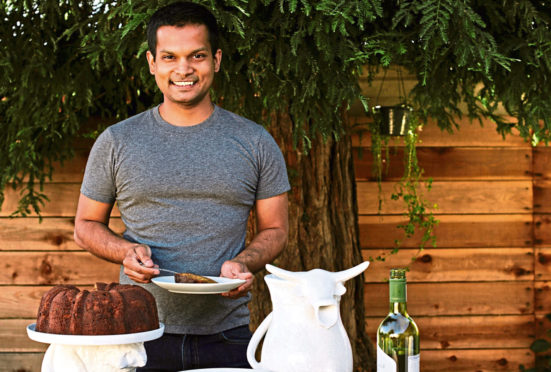
Food writer Nik Sharma talks us through the science of flavour – and explains kitchens are just labs with white aprons instead of coats.
Nik Sharma is based in LA, California. A city of farmers’ markets and cutting-edge restaurants, tacos you’d sell a limb for (if pushed), and ridiculously fresh produce.
“The food scene in LA is the most vibrant in the US,” says Nik. “You can get the mos delicious and inventive meals at different price points, so everyone has access, which is amazing. Mexican food, obviously, is the best – in my opinion.
“It’s also always unexpected. You never know what you’re going to walk into and that’s what I love.”
Covid has put a hold on much of that, however. LA’s been badly hit and Nik misses the restaurants – and simple things like “going to the store, picking things out, the tactile feeling” of holding a lemon before popping it in a basket.
Like most of us, he’s been cooking a lot at home. But as a food writer who cooks at home for a living anyway, he’s had to remind himself he “can’t make desserts all the time, I need to cook savoury food…”
Nigella is a fan (she even lent him a no-churn ice cream recipe for his new book), but if you’re new to his food, he describes it “adventurous and fun” and “unbound by any shackles or rules. It’s more defined by what flavour is – and what it could be.”
At its core is an awareness of science and the role of science in the kitchen. With his new cookbook, The Flavor Equation, he’s “trying to show that science and cooking coexist harmoniously in the kitchen” and that neither side needs be afraid of the other.
“I want people to see the kitchen as a lab,” he notes. “What you’re doing in the kitchen, it’s actually science.”
The Flavor Equation follows Bombay-born Nik’s debut cookbook, Season, and sees him using science to extract deliciousness; investigating how perception affects how we eat; and considering the impact of emotion, sight, sound, mouth-feel, aroma and taste on flavour.
The recipes, meanwhile, “provide experimental basis, and they’re fun”, says Nik – essentially, they’re the practical portion. We learn about fieriness through chicken lollipops, savouriness via stir-fried cabbage, sweetness thanks to masala cheddar cornbread, and bitterness due to a shaved Brussels sprout salad – picking up snippets of science with each page. It’s sensible, useful stuff too; not complicated formulas your science teacher would have thrown at you.
For instance, explains Nik, “some pigments are fat soluble, some are not, you don’t want to stain your hands when you’re working with beets – we know that the pigments in beets are water soluble.
So, if you add water, it’s going to stain everything. Now if you rub oil all over the place, it won’t stain.”
That alone will save your palms and work surfaces from turning hot pink.
Beyond the science, when it comes to cooking, Nik thinks an “ability to experiment” and “willingness to fail” are both crucial. “When I fail in the kitchen, I’m driven to find out what went wrong, and then fix it. Trying to solve that process, or getting to the fixing part, is where you learn a lot,” he says. “That makes you wiser, because not only will you learn to fix that mistake but you can then take and apply that knowledge elsewhere.”
Not that you can fix every slumped soufflé, rock solid gingerbread or bland pasta dish: “Scientists are always pushed in the direction that you have to – and should – problem-solve everything. Bioethics will tell you otherwise.”
Nik ate a lot of seafood growing up on the west coast of India, alongside the meat-driven food of his mother’s Goan background.
American cuisine has since filtered in, alongside the words of what Nik calls the “Holy Trinity” of food writing: Nigella, Diana Henry and Nigel Slater. He’s also a huge Bake Off fan (“I watch it after the entire thing comes out, so I can just binge”).
Some of the images in The Flavor Equation were actually shot using a microscope. “I don’t want people to feel overwhelmed,” he continues, adding that a concern he has with a lot of cookbooks that focus on food from different countries is the fixation with props. “Indian cooking for example, there’s always this tendency to show old props (bowls, plates, glasses). Having lived in India, we never ate from an old rusted bowl.”
This exoticising and romanticism of certain food cultures, and how they ought to be presented is problematic he says, when the “reality is, most people just eat very simply every day.” All of us cooking in our wonderful personal science labs.
The Flavour
Kala namak, or Indian black salt, acts as a brining salt and also as a flavouring agent for meat such as lamb. The combination of salt and acid in a marinade changes protein structure. In the case of red meat, the tough collagen starts to solubilize, and the tissue swells as it retains water and is tenderised. So, the cooked meat will be tender and juicy.

Enjoy the convenience of having The Sunday Post delivered as a digital ePaper straight to your smartphone, tablet or computer.
Subscribe for only £5.49 a month and enjoy all the benefits of the printed paper as a digital replica.
Subscribe